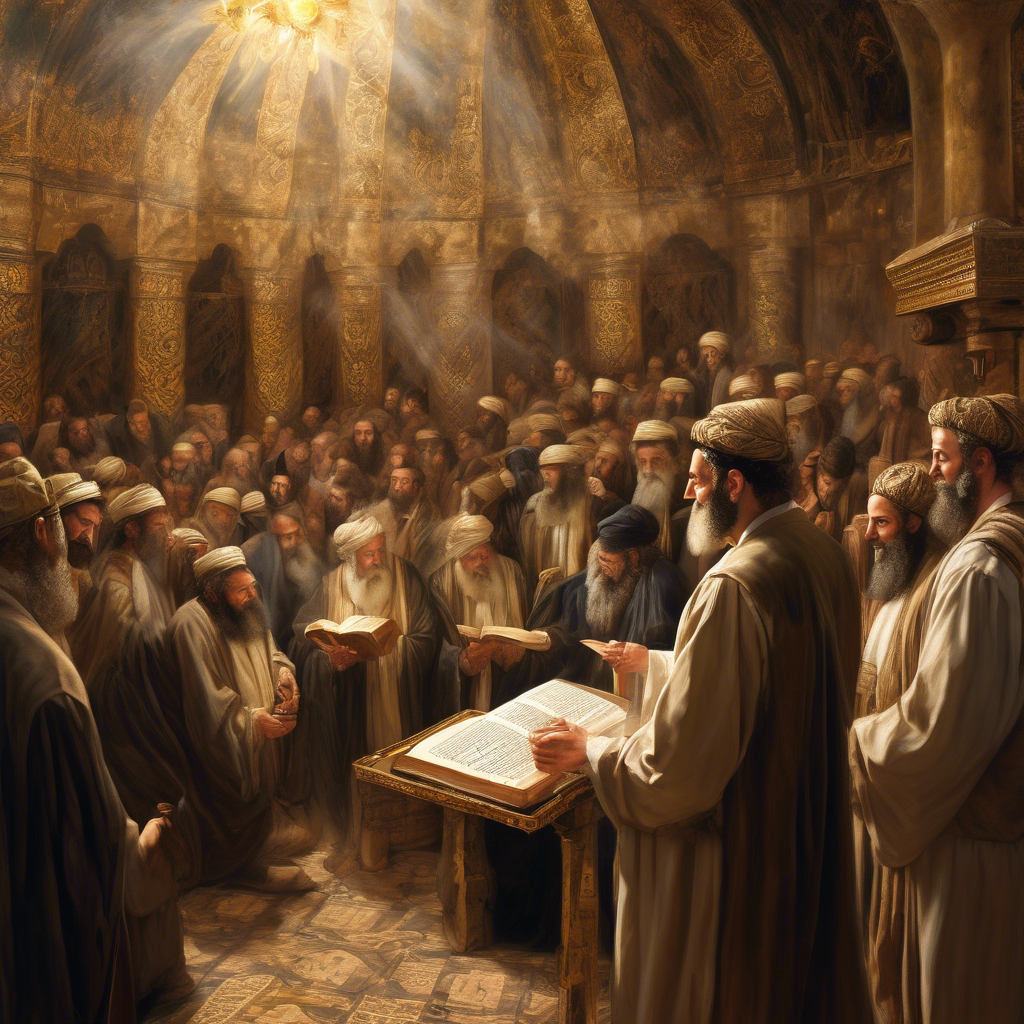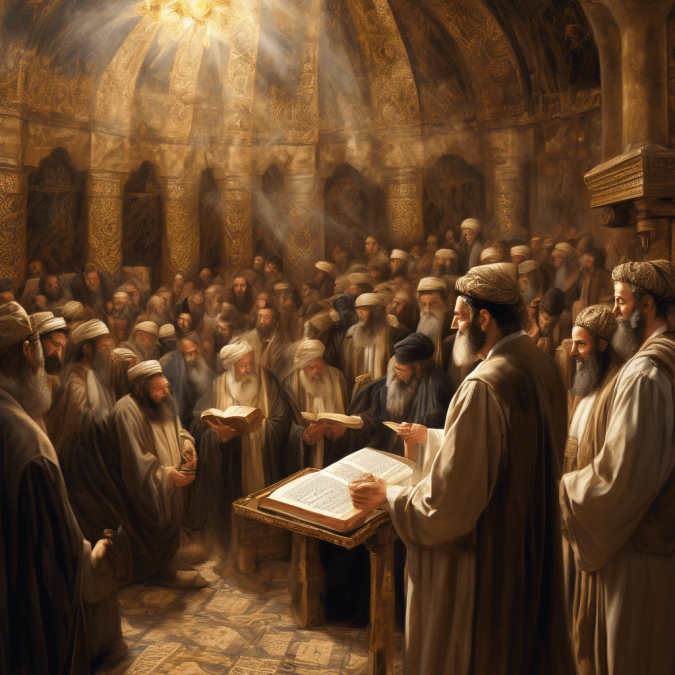
Judaism is one of the oldest monotheistic religions, with a history spanning over 3,000 years. It originated in the Middle East and is centered around the beliefs and practices of the Jewish people. Judaism is based on the Torah, the sacred text that includes the Five Books of Moses. It encompasses various religious laws, rituals, and ethical teachings. Central to Judaism is the belief in one God, who is seen as the creator of the universe and the source of moral guidance. The religion places a strong emphasis on the concept of covenant, a special relationship between God and the Jewish people. Jewish worship takes place in synagogues, and important religious festivals include Passover, Yom Kippur, and Hanukkah. Judaism has diverse branches, including Orthodox, Conservative, and Reform, each with their own interpretations and practices.
One of the foundational stories in Judaism is the story of the Exodus, which is recounted in the Book of Exodus in the Torah. According to the story, the Israelites were enslaved in Egypt for generations. God heard their cries and sent Moses to lead them out of bondage and into the Promised Land. Through a series of miraculous events, including the ten plagues and the parting of the Red Sea, the Israelites escaped from Egypt and began their journey to freedom.
During their journey in the desert, God forged a covenant with the Israelites at Mount Sinai, where Moses received the Ten Commandments. The commandments, which include instructions on ethical behavior and worship, became the foundation of Jewish law and morality.
The story of the Exodus is central to Jewish identity and is commemorated annually during the holiday of Passover. During this holiday, Jews retell the story of their liberation from slavery and celebrate their freedom. The Exodus story serves as a reminder of God’s faithfulness, the importance of justice and compassion, and the enduring bond between God and the Jewish people.
In Judaism, there is a belief in one God, known as Yahweh or Adonai. This monotheistic belief is central to Jewish theology and is expressed in the Shema, a fundamental declaration of faith: “Hear, O Israel: the Lord our God, the Lord is one.” God is seen as the creator of the universe, the source of all life, and the ultimate authority in Jewish religious and ethical teachings.
God is often described as compassionate, just, and merciful, but also as a God of judgment and righteousness. In Jewish tradition, God is transcendent and beyond human comprehension, yet also immanent and present in the world. God is believed to be actively involved in the lives of individuals and the history of the Jewish people.
While God is understood as a singular divine being in Judaism, there are different names and attributes used to describe God in the Hebrew Bible (Old Testament). These include Elohim (God), El Shaddai (God Almighty), and Adonai (Lord). Each name conveys different aspects of God’s nature and relationship with humanity.
Overall, the concept of God in Judaism is characterized by a deep sense of awe, reverence, and devotion, and plays a central role in Jewish worship, prayer, and ethical teachings.
In traditional Jewish society, social classes were not as rigidly defined or hierarchical as in some other cultures. However, there were certain distinctions based on occupation, education, and religious observance.
1. Rabbis and Scholars: At the top of the social hierarchy were rabbis and scholars, who were respected for their knowledge of Jewish law and teachings. They often served as spiritual leaders and educators in the community.
2. Merchants and Professionals: Middle-class Jews typically included merchants, artisans, and professionals such as doctors, lawyers, and teachers. These individuals were often well-educated and financially comfortable.
3. Artisans and Laborers: Working-class Jews included artisans, laborers, and tradespeople who engaged in manual or skilled labor. They often lived modestly and worked hard to support their families.
4. Farmers and Agricultural Workers: In agrarian societies, Jewish farmers and agricultural workers formed another segment of the population. They lived in rural areas and were involved in cultivating land and raising livestock.
5. Poor and Needy: There was also a segment of the Jewish population that struggled with poverty and relied on charity for support. Jewish communities had a strong tradition of providing for the less fortunate through tzedakah (charitable giving).
It’s important to note that these social classes were not strictly defined and individuals could move between them based on factors such as economic success, education, and social connections. Additionally, Jewish communities historically valued education, scholarship, and social responsibility, emphasizing the importance of ethical behavior and caring for those in need.
Judaism has a rich literary tradition that includes a diverse range of sacred texts, historical accounts, commentaries, and philosophical works. Here are some key books and texts in Judaism:
1. Torah: The Torah, also known as the Five Books of Moses, is the central and most sacred text in Judaism. It includes the books of Genesis, Exodus, Leviticus, Numbers, and Deuteronomy, and contains foundational teachings, laws, and narratives that form the basis of Jewish faith and practice.
2. Talmud: The Talmud is a central text of Rabbinic Judaism, consisting of two main components: the Mishnah and the Gemara. The Mishnah is a compilation of Jewish oral law and traditions, while the Gemara is a commentary and analysis of the Mishnah. The Talmud is a comprehensive work that addresses legal, ethical, and theological issues.
3. Midrash: Midrashic literature consists of rabbinic interpretations, explanations, and elaborations on the biblical text. Midrashim provide insights into the meanings and lessons of the Torah and are often used in Jewish study and teaching.
4. Siddur: The Siddur is the Jewish prayer book that contains a collection of prayers, blessings, and liturgical texts used in Jewish worship services. Different Jewish denominations have their own versions of the Siddur.
5. Zohar: The Zohar is a foundational text of Kabbalah, Jewish mysticism. It explores mystical interpretations of the Torah, the nature of God, and the spiritual dimensions of creation.
6. Pirkei Avot: Pirkei Avot, also known as the Ethics of the Fathers, is a collection of ethical teachings and maxims from various Jewish sages and scholars. It offers guidance on moral conduct, character development, and wisdom.
7. Sefer HaChinuch: The Sefer HaChinuch is a medieval work that outlines the 613 commandments (mitzvot) found in the Torah, providing explanations and insights into each commandment.
These are just a few examples of the many important books and texts in Judaism that have shaped Jewish thought, practice, and identity throughout history.
Rituals play a central role in Jewish religious life, providing structure, meaning, and spiritual connection to individuals and communities. Here are some key rituals and practices in Judaism:
1. Shabbat: Shabbat, or the Sabbath, is a weekly day of rest and spiritual rejuvenation that begins at sunset on Friday and ends at nightfall on Saturday. Observant Jews refrain from work, engage in prayer and study, light candles, share festive meals, and attend synagogue services during Shabbat.
2. Kashrut: Kashrut refers to the Jewish dietary laws that dictate what foods are permissible (kosher) and forbidden (non-kosher) for consumption. Observant Jews follow specific guidelines regarding the preparation and consumption of food, including the separation of meat and dairy products.
3. Brit Milah: Brit Milah, or circumcision, is a ritual circumcision ceremony performed on Jewish male infants on the eighth day of life. It symbolizes the covenant between God and the Jewish people and is considered a fundamental commandment in Judaism.
4. Bar/Bat Mitzvah: Bar Mitzvah (for boys) and Bat Mitzvah (for girls) mark the coming-of-age ceremony for Jewish adolescents, typically at age 13. During these ceremonies, the young person takes on new religious responsibilities and is recognized as an adult member of the Jewish community.
5. Yom Kippur: Yom Kippur, the Day of Atonement, is the holiest day in the Jewish calendar. It is a day of fasting, prayer, and repentance, during which Jews seek forgiveness for their sins and commit to self-improvement.
6. Passover: Passover, or Pesach, commemorates the liberation of the Israelites from slavery in Egypt. It is celebrated with a ritual meal called the Seder, during which the story of the Exodus is retold, special foods are eaten, and traditional prayers are recited.
7. Hanukkah: Hanukkah, also known as the Festival of Lights, celebrates the rededication of the Second Temple in Jerusalem. It is observed by lighting the menorah, playing dreidel games, and eating foods cooked in oil to commemorate the miracle of the oil that lasted for eight days.
These are just a few examples of the many rituals and practices that are observed in Judaism. Rituals serve to connect individuals to their faith, history, and community, and provide opportunities for spiritual growth and reflection.
In Judaism, religious rules and laws are derived from the Torah, which includes the Five Books of Moses (Genesis, Exodus, Leviticus, Numbers, and Deuteronomy) and other sacred texts. These rules, known as mitzvot, encompass a wide range of ethical, moral, and ritual obligations that guide the behavior and practices of Jewish individuals and communities. Here are some key categories of religious rules in Judaism:
1. Kashrut (Dietary Laws): Kashrut outlines the dietary restrictions and guidelines for what foods are considered kosher (permissible) and non-kosher (forbidden). This includes rules about which animals can be eaten, how food must be prepared and cooked, and the separation of meat and dairy products.
2. Shabbat Observance: Observing Shabbat, the Jewish day of rest, involves refraining from work, engaging in prayer and study, lighting candles, and spending time with family and community. Specific rules govern what activities are permitted and prohibited on Shabbat.
3. Prayer and Worship: Jewish prayer services follow specific liturgical formats and times, including daily prayers, blessings, and special services for holidays and life cycle events. The Siddur, or prayer book, contains the texts and guidelines for Jewish worship.
4. Laws of Family Purity: Traditional Jewish laws address issues of family purity, including guidelines for marital relations, menstruation, and ritual purification. Observant Jewish couples follow these rules as part of their religious practice.
5. Laws of Charity and Social Justice: Judaism places a strong emphasis on caring for the less fortunate and upholding principles of justice and compassion. The concept of tzedakah (charitable giving) and ethical guidelines for fair treatment of others are central to Jewish religious teachings.
6. Festivals and Holidays: Jewish festivals and holidays have specific rituals, customs, and observances associated with them. These include Passover, Yom Kippur, Sukkot, Hanukkah, and others, each with its own set of rules and practices.
These religious rules and laws serve to guide Jewish individuals in leading a life of piety, ethical conduct, and spiritual connection to God and the Jewish community. Adherence to these rules varies among different Jewish denominations and individual interpretations.
